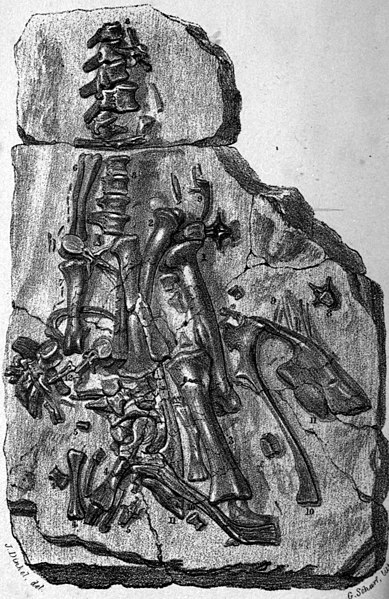Iguanodon, named in 1825, is a genus of iguanodontian dinosaur. While many species found worldwide have been classified in the genus Iguanodon, dating from the Late Jurassic to Early Cretaceous, taxonomic revision in the early 21st century has defined Iguanodon to be based on one well-substantiated species: I. bernissartensis, which lived during the Barremian to early Aptian ages of the Early Cretaceous in Belgium, Germany, England, and Spain, between about 126 and 122 million years ago. Iguanodon was a large, bulky herbivore, measuring up to 9–11 metres (30–36 ft) in length and 4.5 metric tons in body mass. Distinctive features include large thumb spikes, which were possibly used for defense against predators, combined with long prehensile fifth fingers able to forage for food.
Iguanodon
The original I. anglicus teeth from Mantell's 1825 paper
Mantell's "Iguanodon" restoration based on the Maidstone Mantellodon remains
Fossil iguanodont remains found in Maidstone in 1834, now classified as Mantellisaurus
The Iguanodontia are a clade of herbivorous dinosaurs that lived from the Middle Jurassic to Late Cretaceous. Some members include Camptosaurus, Dryosaurus, Iguanodon, Tenontosaurus, and the hadrosaurids or "duck-billed dinosaurs". Iguanodontians were one of the first groups of dinosaurs to be found. They are among the best known of the dinosaurs, and were among the most diverse and widespread herbivorous dinosaur groups of the Cretaceous period.
Iguanodontia
Skeletal mount of Dryosaurus at the Beneski Museum of Natural History
Skeletal mount of Camptosaurus at the Museum of Western Colorado's Dinosaur Journey Museum







